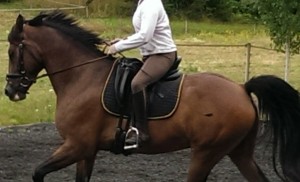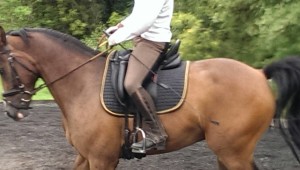At a Ridefit clinic I taught recently, one of the riders was a fit and flexible woman who regularly participates in ballet classes. Her balance on the ground is highly developed, and so I expected her balance on her horse to be equally impressive. Yet, her balance on her horse simply did not measure up to expectations. Her ear, shoulder, hip, heel alignment was completely skewed, and she had to struggle to keep from falling behind the horse’s motion. Knowing that, all things being equal, this woman should have had beautiful alignment on her horse based on her excellent balance on the ground, I started looking for reasons for this disconnect. What I found was that the thigh blocks of her very fine Dressage saddle were preventing her body from finding its own correct balance.
This is a very common problem I find when riders first try Ridefit. The large thigh blocks on the most popular brands of saddle make many riders feel more secure, by preventing their knee from slipping forward on the saddle flap. This can very helpful for riders whose balance is not yet developed enough to have a truly secure seat, and because this is the vast majority of amateur riders in the world of Dressage, it has become the standard in dressage saddle design. Yet, when I work with these riders to develop their balance, remove physical restrictions and tension from their bodies, and increase their core stability, they often find that the thigh blocks ultimately interfere with their body finding equilibrium in the saddle. For some, the thigh blocks push their knees outward which puts their hips into tension, limiting their ability to move freely with the horse. Others find that the thigh blocks keep their upper legs too far back, causing their pelvis to tip forward, restricting the movement of their lower backs and placing their center of gravity too far back – and the rider behind the movement. Whenever I see this, I check to see if we can remove the thigh blocks. When we can, the riders find that they actually feel much more secure, and balance themselves with much greater ease. When we can’t, we have to find other ways to help the rider sit over the horse in balance.
of saddle make many riders feel more secure, by preventing their knee from slipping forward on the saddle flap. This can very helpful for riders whose balance is not yet developed enough to have a truly secure seat, and because this is the vast majority of amateur riders in the world of Dressage, it has become the standard in dressage saddle design. Yet, when I work with these riders to develop their balance, remove physical restrictions and tension from their bodies, and increase their core stability, they often find that the thigh blocks ultimately interfere with their body finding equilibrium in the saddle. For some, the thigh blocks push their knees outward which puts their hips into tension, limiting their ability to move freely with the horse. Others find that the thigh blocks keep their upper legs too far back, causing their pelvis to tip forward, restricting the movement of their lower backs and placing their center of gravity too far back – and the rider behind the movement. Whenever I see this, I check to see if we can remove the thigh blocks. When we can, the riders find that they actually feel much more secure, and balance themselves with much greater ease. When we can’t, we have to find other ways to help the rider sit over the horse in balance.
Such was the case with my ballerina student. Her thigh blocks were forcing her upper leg and hips too far back, making her have to try and compensate with her upper body and lower leg (both coming forward) in an effort to stay over the horse’s center of gravity. The only other way to correct this is to have the rider put her lower leg back about 4 to 6 inches, which brings the lower body into balance, and allows the upper body to settle into a much better state of equilibrium. As you can see from the photos, the difference is dramatic, and the rider is suddenly able to flow with the horse’s movement. Consequently, the horse is able to stay more actively forward and will exhibit fewer losses of balance him/herself – which generally results in less “falling” out of the canter…
This is still not ideal, because it still leaves the lower back with a necessarily shortened range of motion, as it is restrained between the thigh block and the cantle of the saddle, but it is tremendously better than the alternative!
For the thousands of riders out there who look like the first picture, please try removing your thigh blocks, and see what happens. If they are not removable, before you start looking for a new saddle, try moving your lower leg back and see if your body will find its own balance more easily. Finding a saddle that fits your horse properly can be a true test of one’s patience and perseverance, so having an option to adjust one’s body to give your horse a better ride can be a real life saver!
Until next time, ride fit!


I like the valuable info you provide for your articles.
I will boookmark your log and check once more right here regularly.
I am reasonably sure I will learn many new stuff proper here!
Good luck for thhe following! https://Leon.bet/en-au/casino
6ucjmb